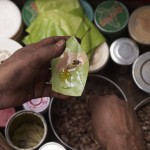
The use of betel quid and areca nut chewing is common in many south and south eastern Asian countries. Use of betel quid and areca nut is linked to the development of potentially malignant oral conditions and is prevalent in in a number of areas with high incidence of oral cancer.
The aim of this review was to explore the links between the habit of betel quid and areca nut (BQ-AN) chewing and the prognosis of oral cancer.
Methods
Searches were conducted in the PubMed, Web of Science, Embase, Epistemonikos and OpenGrey databases. Studies with more than 100 patients reporting the association between BQ-AN chewing and prognosis of oral cancer providing information on 5-year overall survival (OS) or disease specific survival (DSS) providing data on hazard ratios (HR) and 95% confidence intervals (CI) were considered. Only English language papers were included. Two reviewers independently reviewed selected and extracted data for the studies. studies Study quality was assessed independently by two reviewers using the Newcastle-Ottawa Scale. The pooled HR with 95% CI of 5-year OS and 5-year DSS was calculated using a fixed-effects model.
Results
- 11 observational studies reported in 10 papers involving a total of 4614 patients were included.
- All the studies except one conducted in Malaysia were conducted in Taiwan.
- All the studies were considered to be of moderate quality.
- Meta-analysis showed significant better survival in patients without a BQ-AN habit both in terms of overall survival and disease specific survival (see table).
| No. of studies (Patients) | Hazard Ratio (95% CI) | |
| Overall survival |
8 (2,761) | 1.26 (1.09–1.46) |
| Disease specific survival |
4 (2,551) | 1.40 (1.15– 1.70) |
Conclusions
The authors concluded: –
Betel quid and areca nut chewing is significantly associated with low 5-year overall survival and disease specific survival in patients with oral cancer, although the potential bias should be carefully considered.
Comments
The authors have searched a number of databases for relevant studies although restricting inclusion to English language only may have excluded some relevant studies. While 11 studies were included in the analysis all but one was from Taiwan this should be taken into consideration as it may be that the findings might not be more broadly generalisable. In the discussion the authors do note that differences in the components of betel quid are found in different geographical areas for example, tobacco is frequently added in India but not in the Chinese mainland or Taiwan. Consequently additional research is needed into the role of BQ-AN as both a risk factor for oral cancer as well as its impact on prognosis.
Links
Primary Paper
Yang J, Wang ZY, Huang L, Yu TL, Wan SQ, Song J, Zhang BL, Hu M. Do betel quid and areca nut chewing deteriorate prognosis of oral cancer? A systematic review, meta-analysis, and research agenda. Oral Dis. 2020 Jun 3. doi: 10.1111/odi.13456. Epub ahead of print. PMID: 32492239.
Other references
Dental Elf – 8th Aug 2018
